Deep-Learning-Based Probabilistic Forecasting of Groundwater Storage Dynamics in Sudan Using Multisource Remote Sensing and Geophysical Data
Highlights
- The integrated machine learning approach successfully reconstructed gaps in GRACE/GRACE-FO data and produced reliable forecasts of groundwater storage dynamics with quantified uncertainty.
- Groundwater storage anomalies in Sudan shows a consistent long-term recovery trend, with the strongest increases observed in semi-tropical regions.
- The developed framework demonstrates how combining satellite observations with machine learning can guide sustainable groundwater monitoring and management in data-scarce and climate-stressed regions.
- The findings provide new evidence that groundwater is the dominant driver of water storage variability in Sudan, underscoring its critical role in sustaining water supply for domestic and agricultural purposes.
Abstract
1. Introduction
- Fill gaps in the GRACE/GRACE-FO record using land surface variables from, ensuring a continuous time series of TWS and GWS.
- Analyze long-term trends and variability in GWS anomalies from the completed time series, highlighting regional patterns across different hydroclimatic and hydrogeological settings.
- Forecast GWS anomalies up to three years beyond the observational record using a Bi-LSTM model and quantify uncertainty through ensemble modeling, providing probabilistic insights into the reliability of the forecasted GWS anomalies.
2. Description of the Study Area
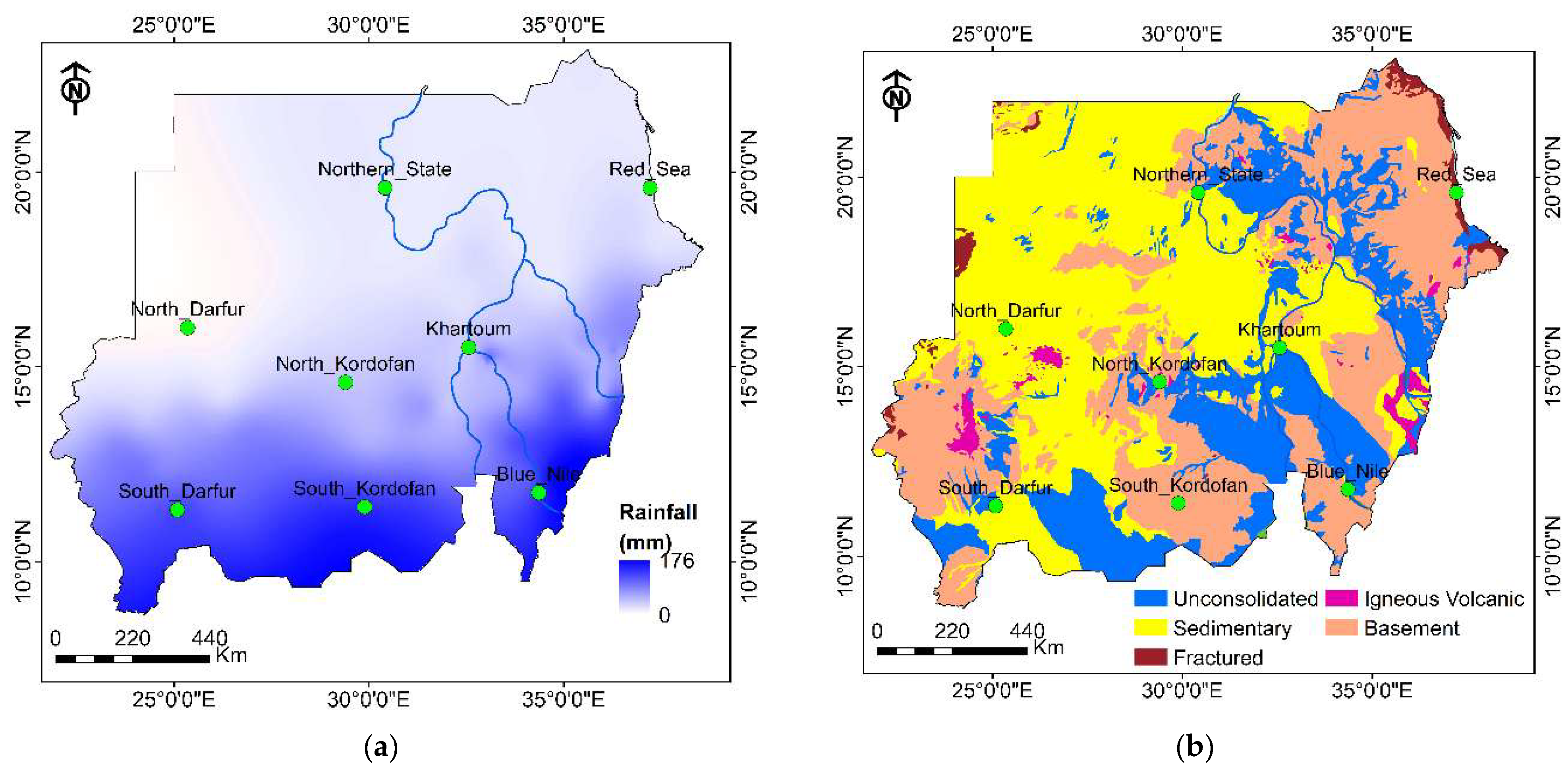
3. Materials and Methods
3.1. GRACE/GRACE-FO
3.2. GLDAS
3.3. Random Forest
3.4. Bi-Directional Long-Short Term Memory (Bi-LSTM)
3.5. Bootstrap Resampling Method
3.6. Hyperparameters and Performance of the Bootstrapped BiLSTM Model
3.7. Trend Decomposition and Analysis
4. Results and Discussion
4.1. Filling Gabs in TWS Anomalies
4.2. Groundwater Storage Change
4.3. Decomposition and Prediction of GWS
4.4. Forecasting and Uncertainty Analysis
4.5. Trend Analysis of the Forecasted GWS Anomalies
5. Conclusions
Supplementary Materials
Author Contributions
Funding
Data Availability Statement
Acknowledgments
Conflicts of Interest
Correction Statement
References
- Frappart, F.; Ramillien, G. Monitoring Groundwater Storage Changes Using the Gravity Recovery and Climate Experiment (GRACE) Satellite Mission: A Review. Remote Sens. 2018, 10, 829. [Google Scholar] [CrossRef]
- Masood, A.; Tariq, M.A.U.R.; Hashmi, M.Z.U.R.; Waseem, M.; Sarwar, M.K.; Ali, W.; Farooq, R.; Almazroui, M.; Ng, A.W.M. An Overview of Groundwater Monitoring through Point-to Satellite-Based Techniques. Water 2022, 14, 565. [Google Scholar] [CrossRef]
- Ali, S.; Liu, D.; Fu, Q.; Cheema, M.J.M.; Pham, Q.B.; Rahaman, M.M.; Dang, T.D.; Anh, D.T. Improving the Resolution of GRACE Data for Spatio-Temporal Groundwater Storage Assessment. Remote Sens. 2021, 13, 3513. [Google Scholar] [CrossRef]
- Rateb, A.; Scanlon, B.R.; Pool, D.R.; Sun, A.; Zhang, Z.; Chen, J.; Clark, B.; Faunt, C.C.; Haugh, C.J.; Hill, M.; et al. Comparison of Groundwater Storage Changes from GRACE Satellites with Monitoring and Modeling of Major US Aquifers. Water Resour. Res. 2020, 56, e2020WR027556. [Google Scholar] [CrossRef]
- Yidana, S.M.; Dzikunoo, E.A.; Mejida, R.A.; Ackom, E.K.; Chegbeleh, L.P.; Loh, Y.S.A.; Banoeng-Yakubo, B.K.; Akabzaa, T.M. Evaluating Groundwater Resources Trends through Multiple Conceptual Models and GRACE Satellite Data. Environ. Monit. Assess. 2024, 196, 290. [Google Scholar] [CrossRef] [PubMed]
- Ding, K.; Zhao, X.; Cheng, J.; Yu, Y.; Luo, Y.; Couchot, J.; Zheng, K.; Lin, Y.; Wang, Y. GRACE/ML-Based Analysis of the Spatiotemporal Variations of Groundwater Storage in Africa. J. Hydrol. 2025, 647, 132336. [Google Scholar] [CrossRef]
- Mohasseb, H.A.; Shen, W.; Jiao, J.; Hassan, A.A. Estimation of Groundwater Storage Variations in African River Basins: Response to Global Climate Change Using GRACE and GRACE-FO among Past Two Decades. Adv. Space Res. 2024, 74, 1164–1182. [Google Scholar] [CrossRef]
- Mohamed, A.; Alarifi, S.S.; Al-Kahtany, K.; Mohammed, M.A.A. Application of Gravity and Remote Sensing Data to Groundwater Storage Variation in Wadi Al Dawasir, Saudi Arabia. J. King Saud. Univ. Sci. 2024, 36, 103172. [Google Scholar] [CrossRef]
- Mohamed, A.; Alarifi, S.S.; Mohammed, M.A.A. Geophysical Monitoring of the Groundwater Resources in the Southern Arabian Peninsula Using Satellite Gravity Data. Alex. Eng. J. 2024, 86, 311–326. [Google Scholar] [CrossRef]
- Nikraftar, Z.; Parizi, E.; Saber, M.; Hosseini, S.M.; Ataie-Ashtiani, B.; Simmons, C.T. Groundwater Sustainability Assessment in the Middle East Using GRACE/GRACE-FO Data. Hydrogeol. J. 2024, 32, 321–337. [Google Scholar] [CrossRef]
- Upadhyay, S.; Shrestha, S.; Loc, H.H.; Mohanasundaram, S.; Dhungana, S.; Lim, S.; Tangdamrongsub, N. Satellite-Based Estimates of Declining Groundwater Storage in the Transboundary Cambodia-Mekong River Delta Aquifer of the Lower Mekong Region, Southeast Asia. Hydrogeol. J. 2024, 32, 601–619. [Google Scholar] [CrossRef]
- Dharpure, J.K.; Howat, I.M.; Kaushik, S. Declining Groundwater Storage in the Indus Basin Revealed Using GRACE and GRACE-FO Data. Water Resour. Res. 2025, 61, e2024WR038279. [Google Scholar] [CrossRef]
- Li, W.; Bao, L.; Yao, G.; Wang, F.; Guo, Q.; Zhu, J.; Zhu, J.; Wang, Z.; Bi, J.; Zhu, C.; et al. The Analysis on Groundwater Storage Variations from GRACE/GRACE-FO in Recent 20 Years Driven by Influencing Factors and Prediction in Shandong Province, China. Sci. Rep. 2024, 14, 5819. [Google Scholar] [CrossRef] [PubMed]
- Nourani, V.; Paknezhad, N.J.; Ng, A.; Wen, Z.; Dabrowska, D.; Üzelaltınbulat, S. Application of the Machine Learning Methods for GRACE Data Based Groundwater Modeling, a Systematic Review. Groundw. Sustain. Dev. 2024, 25, 101113. [Google Scholar] [CrossRef]
- Wang, L.; Zhang, Y. Filling GRACE Data Gap Using an Innovative Transformer-Based Deep Learning Approach. Remote Sens. Environ. 2024, 315, 114465. [Google Scholar] [CrossRef]
- Chen, J.; Wang, L.; Chen, C.; Peng, Z. Downscaling and Gap-Filling GRACE-Based Terrestrial Water Storage Anomalies in the Qinghai–Tibet Plateau Using Deep Learning and Multi-Source Data. Remote Sens. 2025, 17, 1333. [Google Scholar] [CrossRef]
- Yin, W.; Zhang, G.; Liu, F.; Zhang, D.; Zhang, X.; Chen, S. Improving the Spatial Resolution of GRACE-Based Groundwater Storage Estimates Using a Machine Learning Algorithm and Hydrological Model. Hydrogeol. J. 2022, 30, 947–963. [Google Scholar] [CrossRef]
- Kashani, A.; Safavi, H.R. Assessing Groundwater Drought in Iran Using GRACE Data and Machine Learning. Sci. Rep. 2025, 15, 14671. [Google Scholar] [CrossRef]
- Satizábal-Alarcón, D.A.; Suhogusoff, A.; Ferrari, L.C. Characterization of Groundwater Storage Changes in the Amazon River Basin Based on Downscaling of GRACE/GRACE-FO Data with Machine Learning Models. Sci. Total Environ. 2024, 912, 168958. [Google Scholar] [CrossRef]
- Malakar, P.; Mukherjee, A.; Bhanja, S.N.; Ray, R.K.; Sarkar, S.; Zahid, A. Machine-Learning-Based Regional-Scale Groundwater Level Prediction Using GRACE. Hydrogeol. J. 2021, 29, 1027–1042. [Google Scholar] [CrossRef]
- Moudgil, P.S.; Rao, G.S. Groundwater Levels Estimation from GRACE/GRACE-FO and Hydro-Meteorological Data Using Deep Learning in Ganga River Basin, India. Environ. Earth Sci. 2023, 82, 441. [Google Scholar] [CrossRef]
- Mohammed, M.A.A.; Szabó, N.P.; Szűcs, P. Exploring Spatiotemporal Groundwater Flow Patterns in Heterogeneous Systems: A Comprehensive Workflow Combining Multiple Machine Learning Models. Stoch. Environ. Res. Risk Assess. 2025, 1–20. [Google Scholar] [CrossRef]
- Samani, S.; Vadiati, M.; Kisi, O. Predicting Groundwater Levels in Coastal Aquifers Using Deep Learning Models: A Comparative Study of Sedimentary and Metamorphic Aquifers in Nova Scotia. Earth Sci. Inform. 2025, 18, 389. [Google Scholar] [CrossRef]
- Aderemi, B.A.; Olwal, T.O.; Ndambuki, J.M.; Rwanga, S.S. Groundwater Levels Forecasting Using Machine Learning Models: A Case Study of the Groundwater Region 10 at Karst Belt, South Africa. Syst. Soft Comput. 2023, 5, 200049. [Google Scholar] [CrossRef]
- Guo, F.; Li, S.; Zhao, G.; Hu, H.; Zhang, Z.; Yue, S.; Zhang, H.; Xu, Y. A SOM-LSTM Combined Model for Groundwater Level Prediction in Karst Critical Zone Aquifers Considering Connectivity Characteristics. Environ. Earth Sci. 2024, 83, 267. [Google Scholar] [CrossRef]
- Yin, W.; Fan, Z.; Tangdamrongsub, N.; Hu, L.; Zhang, M. Comparison of Physical and Data-Driven Models to Forecast Groundwater Level Changes with the Inclusion of GRACE—A Case Study over the State of Victoria, Australia. J. Hydrol. 2021, 602, 126735. [Google Scholar] [CrossRef]
- Gaffoor, Z.; Pietersen, K.; Jovanovic, N.; Bagula, A.; Kanyerere, T.; Ajayi, O.; Wanangwa, G. A Comparison of Ensemble and Deep Learning Algorithms to Model Groundwater Levels in a Data-Scarce Aquifer of Southern Africa. Hydrology 2022, 9, 125. [Google Scholar] [CrossRef]
- Anderson, M.P.; Woessner, W.W.; Hunt, R.J. Applied Groundwater Modeling: Simulation of Flow and Advective Transport; Academic Press: Cambridge, MA, USA, 2015. [Google Scholar]
- Omer, A. Focus on Groundwater in Sudan. Environ. Geol. 2002, 41, 972–976. [Google Scholar] [CrossRef]
- Mohamed, A.; Sultan, M.; Ahmed, M.; Yan, E.; Ahmed, E. Aquifer Recharge, Depletion, and Connectivity: Inferences from GRACE, Land Surface Models, and Geochemical and Geophysical Data. GSA Bull. 2017, 129, 534–546. [Google Scholar] [CrossRef]
- Bonsor, H.C.; Mansour, M.M.; MacDonald, A.M.; Hughes, A.G.; Hipkin, R.G.; Bedada, T. Interpretation of GRACE Data of the Nile Basin Using a Groundwater Recharge Model. Hydrol. Earth Syst. Sci. 2010, 7, 4501–4533. [Google Scholar]
- Abdelmohsen, K.; Sultan, M.; Ahmed, M.; Save, H.; Elkaliouby, B.; Emil, M.; Yan, E.; Abotalib, A.Z.; Krishnamurthy, R.V.; Abdelmalik, K. Response of Deep Aquifers to Climate Variability. Sci. Total Environ. 2019, 677, 530–544. [Google Scholar] [CrossRef]
- Mohammed, M.A.A.; Szabó, N.P.; Szűcs, P. Multivariate Statistical and Hydrochemical Approaches for Evaluation of Groundwater Quality in North Bahri City-Sudan. Heliyon 2022, 8, e11308. [Google Scholar] [CrossRef]
- Osman, Y.Z.; Shamseldin, A.Y. Qualitative Rainfall Prediction Models for Central and Southern Sudan Using El Niño—Southern Oscillation and Indian Ocean Sea Surface Temperature Indices. Int. J. Climatol. A J. R. Meteorol. Soc. 2002, 22, 1861–1878. [Google Scholar] [CrossRef]
- Ilyés, C.; Mohammed, M.A.A.; Szabó, N.P.; Szűcs, P. A Hybrid Approach to Exploring the Spatiotemporal Patterns of Precipitation in Sudan: Insights from Neural Network Clustering and Fourier-Wavelet Transform Analysis. Water Cycle 2025. [Google Scholar] [CrossRef]
- Elsheikh, A.E.M.; Zeinelabdein, K.A.E.; El-Khidir, S.O.H. The Use of Remote Sensing and GIS Techniques as a Guide to Other Geological Methods for Groundwater Investigations in Hamisana Basement Terrains, Red Sea Hills, NE Sudan. Int. J. Geosci. Geomat. 2014, 2, 40–46. [Google Scholar]
- Mohammed, M.A.A. The Use of Landsat ETM+ in Hydrogeological Investigation in Basement Terrain, Hamissana Area, N-E Sudan. Humanit. Nat. Sci. J. 2020, 1, 370–378. [Google Scholar] [CrossRef]
- Mohammed, M.A.A.; Abdelrahman, M.M.G.; Szabó, N.P.; Szűcs, P. Innovative Hydrogeophysical Approach for Detecting the Spatial Distribution of Hydraulic Conductivity in Bahri City, Sudan: A Comparative Study of Csókás and Heigold Methods. Sustain. Water Resour. Manag. 2023, 9, 107. [Google Scholar] [CrossRef]
- Lanzoni, M.; Darling, W.G.; Edmunds, W.M. Groundwater in Sudan: An Improved Understanding of Wadi-Directed Recharge. Appl. Geochem. 2018, 99, 55–64. [Google Scholar] [CrossRef]
- Farah, E.A.; Mustafa, E.M.A.; Kumai, H. Sources of Groundwater Recharge at the Confluence of the Niles, Sudan. Environ. Geol. 2000, 39, 667–672. [Google Scholar] [CrossRef]
- Gadelmula, A.; Upton, K.; Dochartaigh, B.; Bellwood, H. Africa Groundwater Atlas: Hydrogeology of Sudan. Available online: https://earthwise.bgs.ac.uk/index.php/Hydrogeology_of_Sudan (accessed on 10 September 2025).
- Tapley, B.D.; Bettadpur, S.; Ries, J.C.; Thompson, P.F.; Watkins, M.M. GRACE Measurements of Mass Variability in the Earth System. Science 2004, 305, 503–505. [Google Scholar] [CrossRef]
- Save, H. CSR GRACE and GRACE-FO RL06 Mascon Solutions V02; University of Texas at Austin: Austin, TX, USA, 2020; Volume 1. [Google Scholar]
- Dobslaw, H.; Flechtner, F.; Bergmann-Wolf, I.; Dahle, C.; Dill, R.; Esselborn, S.; Sasgen, I.; Thomas, M. Simulating High-Frequency Atmosphere-Ocean Mass Variability for Dealiasing of Satellite Gravity Observations: AOD1B RL05. J. Geophys. Res. Ocean. 2013, 118, 3704–3711. [Google Scholar] [CrossRef]
- Bonin, J.; Chambers, D. Uncertainty Estimates of a GRACE Inversion Modelling Technique over Greenland Using a Simulation. Geophys. J. Int. 2013, 194, 212–229. [Google Scholar] [CrossRef]
- Rodell, M.; Houser, P.R.; Jambor, U.E.A.; Gottschalck, J.; Mitchell, K.; Meng, C.-J.; Arsenault, K.; Cosgrove, B.; Radakovich, J.; Bosilovich, M.; et al. The Global Land Data Assimilation System. Bull. Am. Meteorol. Soc. 2004, 85, 381–394. [Google Scholar] [CrossRef]
- Wang, W.; Cui, W.; Wang, X.; Chen, X. Evaluation of GLDAS-1 and GLDAS-2 Forcing Data and Noah Model Simulations over China at the Monthly Scale. J. Hydrometeorol. 2016, 17, 2815–2833. [Google Scholar] [CrossRef]
- Breiman, L. Random Forests. Mach. Learn. 2001, 45, 5–32. [Google Scholar] [CrossRef]
- Tang, S.; Wang, H.; Feng, Y.; Liu, Q.; Wang, T.; Liu, W.; Sun, F. Random Forest-Based Reconstruction and Application of the GRACE Terrestrial Water Storage Estimates for the Lancang-Mekong River Basin. Remote Sens. 2021, 13, 4831. [Google Scholar] [CrossRef]
- Schuster, M.; Paliwal, K.K. Bidirectional Recurrent Neural Networks. IEEE Trans. Signal Process. 1997, 45, 2673–2681. [Google Scholar] [CrossRef]
- Karevan, Z.; Suykens, J.A.K. Transductive LSTM for Time-Series Prediction: An Application to Weather Forecasting. Neural Netw. 2020, 125, 1–9. [Google Scholar] [CrossRef]
- Siami-Namini, S.; Tavakoli, N.; Namin, A.S. The Performance of LSTM and BiLSTM in Forecasting Time Series. In Proceedings of the 2019 IEEE International Conference on Big Data (Big Data), Los Angeles, CA, USA, 9–12 December 2019; pp. 3285–3292. [Google Scholar]
- Davison, A.C.; Hinkley, D.V. Bootstrap Methods and Their Application; Cambridge University Press: Cambridge, UK, 1997. [Google Scholar]
- Tiwari, M.K.; Chatterjee, C. Uncertainty Assessment and Ensemble Flood Forecasting Using Bootstrap Based Artificial Neural Networks (BANNs). J. Hydrol. 2010, 382, 20–33. [Google Scholar] [CrossRef]
- Cleveland, R.B.; Cleveland, W.S.; McRae, J.E.; Terpenning, I. Others STL: A Seasonal-Trend Decomposition. J. Off. Stat. 1990, 6, 3–73. [Google Scholar]
- Sen, P.K. Estimates of the Regression Coefficient Based on Kendall’s Tau. J. Am. Stat. Assoc. 1968, 63, 1379–1389. [Google Scholar] [CrossRef]
- Shepard, D. A Two-Dimensional Interpolation Function for Irregularly-Spaced Data. In Proceedings of the 1968 23rd ACM National Conference, New York, NY, USA, 27–29 August 1968; pp. 517–524. [Google Scholar]
- Gyawali, B.; Ahmed, M.; Murgulet, D.; Wiese, D.N. Filling Temporal Gaps within and between GRACE and GRACE-FO Terrestrial Water Storage Records: An Innovative Approach. Remote Sens. 2022, 14, 1565. [Google Scholar] [CrossRef]
- Jing, W.; Zhang, P.; Zhao, X.; Yang, Y.; Jiang, H.; Xu, J.; Yang, J.; Li, Y. Extending GRACE Terrestrial Water Storage Anomalies by Combining the Random Forest Regression and a Spatially Moving Window Structure. J. Hydrol. 2020, 590, 125239. [Google Scholar] [CrossRef]
- Swenson, S.; Wahr, J. Post-Processing Removal of Correlated Errors in GRACE Data. Geophys. Res. Lett. 2006, 33. [Google Scholar] [CrossRef]
- Feng, W.; Zhong, M.; Lemoine, J.-M.; Biancale, R.; Hsu, H.-T.; Xia, J. Evaluation of Groundwater Depletion in North China Using the Gravity Recovery and Climate Experiment (GRACE) Data and Ground-Based Measurements. Water Resour. Res. 2013, 49, 2110–2118. [Google Scholar] [CrossRef]
- Melesse, A.M.; Abtew, W.; Setegn, S.G.; Dessalegne, T. Hydrological Variability and Climate of the Upper Blue Nile River Basin. In Nile River Basin: Hydrology, Climate and Water Use; Springer: Berlin/Heidelberg, Germany, 2011; pp. 3–37. [Google Scholar]
- Hassan, A.; Jin, S. Water Storage Changes and Balances in Africa Observed by GRACE and Hydrologic Models. Geod. Geodyn. 2016, 7, 39–49. [Google Scholar] [CrossRef]
- Khogly, H. Historical Change in Extreme Precipitation in Sudan and Associated Physical Mechanism. J. Extrem. Events 2025, 2025, 2550001. [Google Scholar] [CrossRef]
- Abdelsalam, M.G. The Nile’s Journey through Space and Time: A Geological Perspective. Earth-Science Rev. 2018, 177, 742–773. [Google Scholar] [CrossRef]
- Salh, Y.H.M.; Su, C.; Iqbal, J.; Usman, U.S.; Yousif, M.H.; Ismail, O. Hydrogeochemical Processes Regulating Groundwater Quality and Its Suitability for Drinking Purposes in the Recent Alluvial Plain, Blue Nile Region, Sudan. Environ. Geochem. Health 2025, 47, 102. [Google Scholar] [CrossRef]
- Mohammed, M.A.A.; Mohamed, A.; Szabó, N.P.; Alari, S.S.; Abdelrady, A.; Alao, J.O.; Sz, P. Investigation of Petrophysical and Hydrogeological Parameters of the Transboundary Nubian Aquifer System Using Geophysical Methods. Front. Earth Sci. 2024, 11, 1295213. [Google Scholar] [CrossRef]
- Hamdan, M.S.; Singh, R.; Pathak, R.; Kumari, S.; Chauhan, V. Geospatial Mapping of Groundwater Potential Zones Using Multi-Criteria Decision-Making AHP Approach: A Study of Kadugli District, South Kurdufan, Sudan. J. Afr. Earth Sci. 2025, 223, 105513. [Google Scholar] [CrossRef]
- Elsheikh, A.E.M.; Zeielabdein, K.A.E.; Babikir, I.A.A. Groundwater Balance in the Khor Arbaat Basin, Red Sea State, Eastern Sudan. Hydrogeol. J. 2009, 17, 2075–2082. [Google Scholar] [CrossRef]
- Feng, D.; Fang, K.; Shen, C. Enhancing Streamflow Forecast and Extracting Insights Using Long-Short Term Memory Networks with Data Integration at Continental Scales. Water Resour. Res. 2020, 56, e2019WR026793. [Google Scholar] [CrossRef]
- Kratzert, F.; Klotz, D.; Shalev, G.; Klambauer, G.; Hochreiter, S.; Nearing, G. Towards Learning Universal, Regional, and Local Hydrological Behaviors via Machine Learning Applied to Large-Sample Datasets. Hydrol. Earth Syst. Sci. 2019, 23, 5089–5110. [Google Scholar] [CrossRef]
- Jia, Z.; Zhang, Q.; Shi, B.; Xu, C.; Liu, D.; Yang, Y.; Xi, B.; Li, R. A New Strategy for Groundwater Level Prediction Using a Hybrid Deep Learning Model under Ecological Water Replenishment. Environ. Sci. Pollut. Res. 2024, 31, 23951–23967. [Google Scholar] [CrossRef]
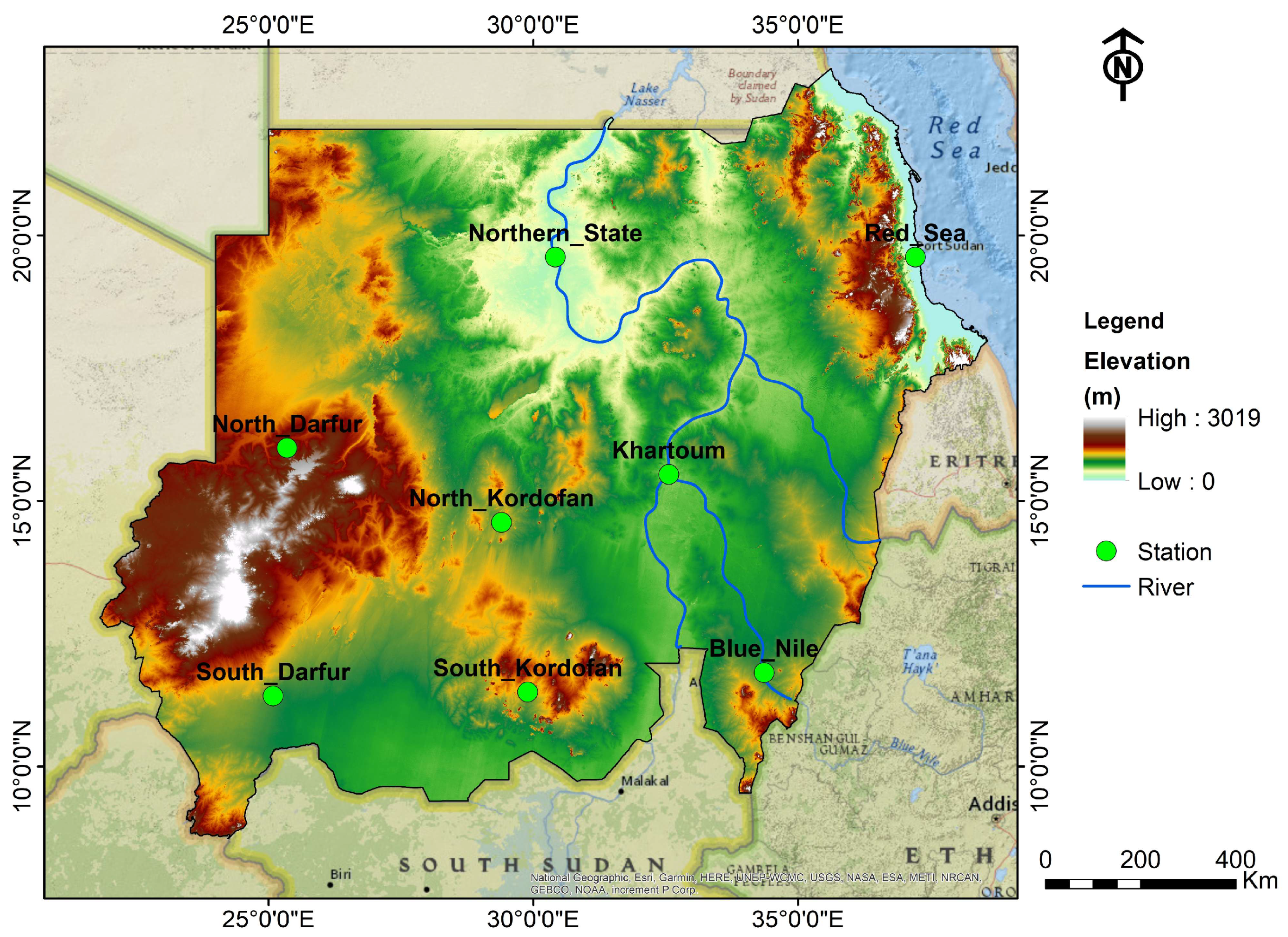
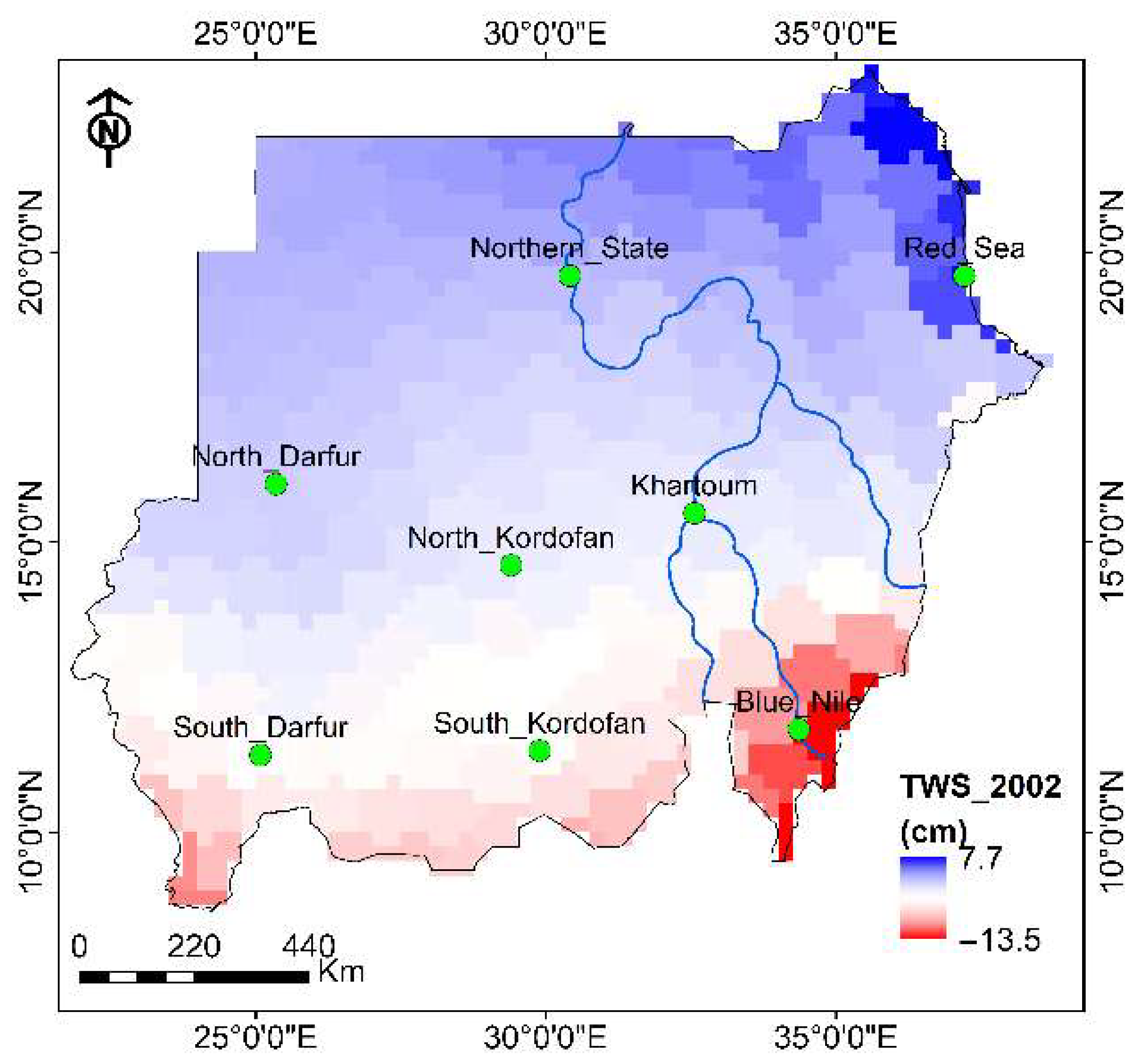
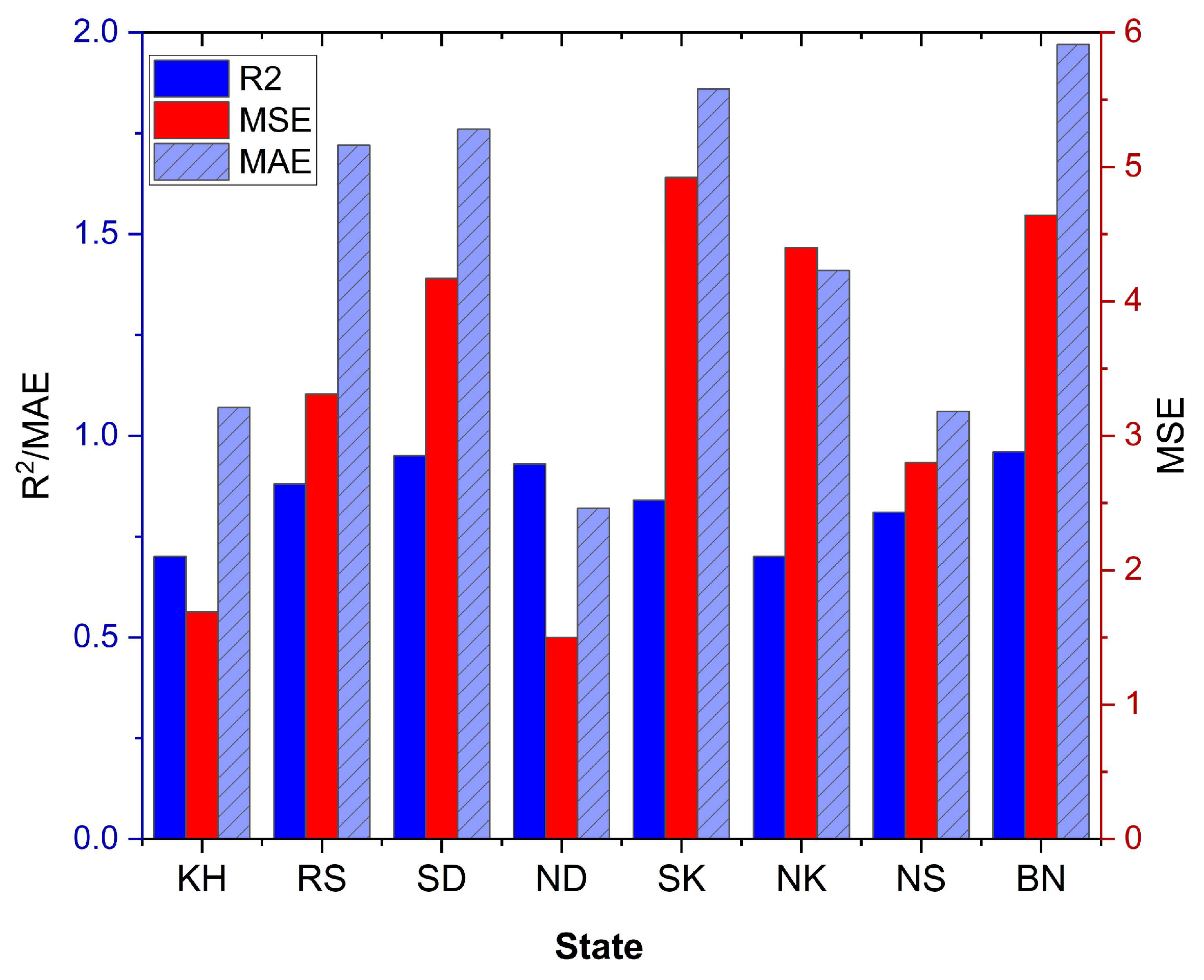
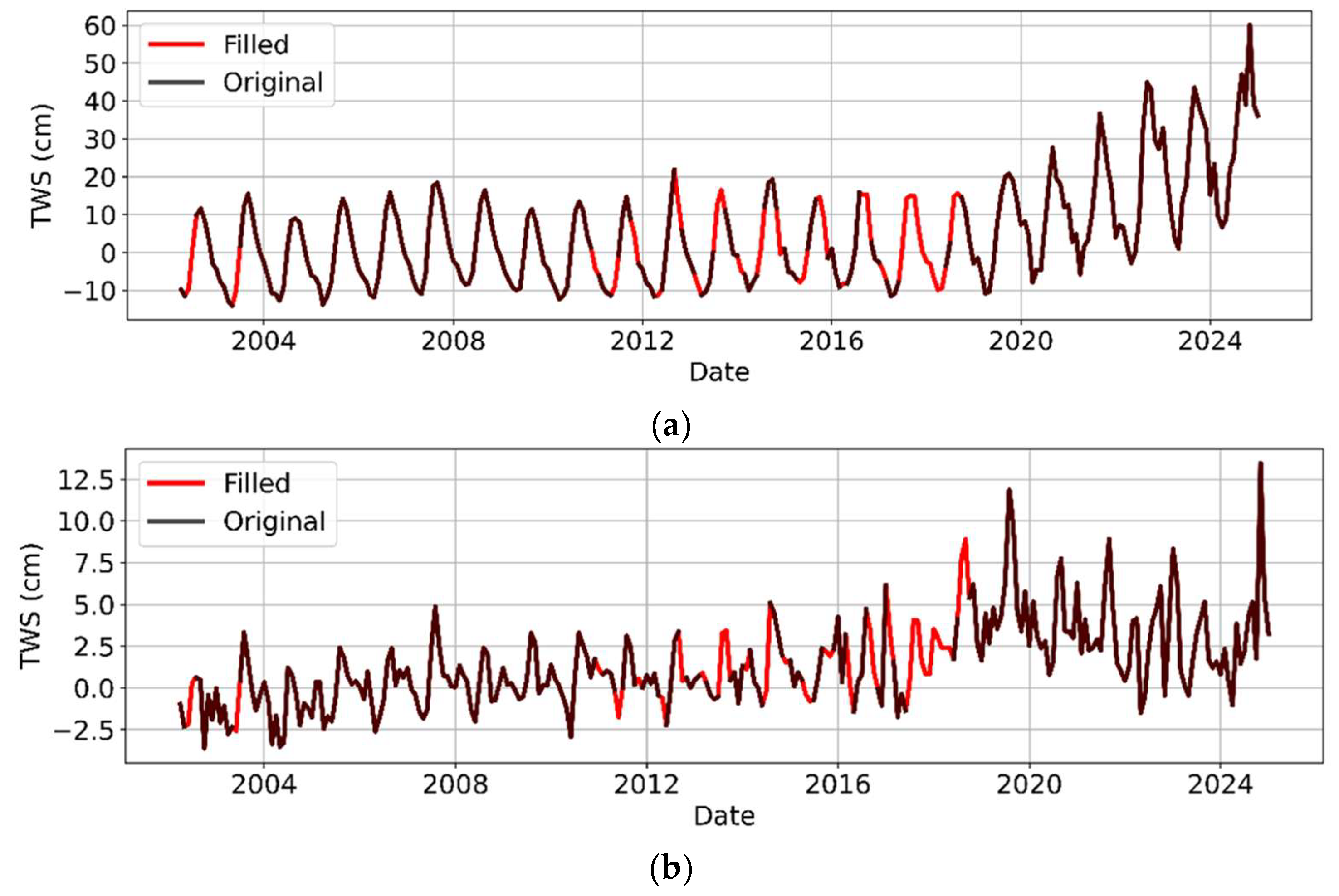
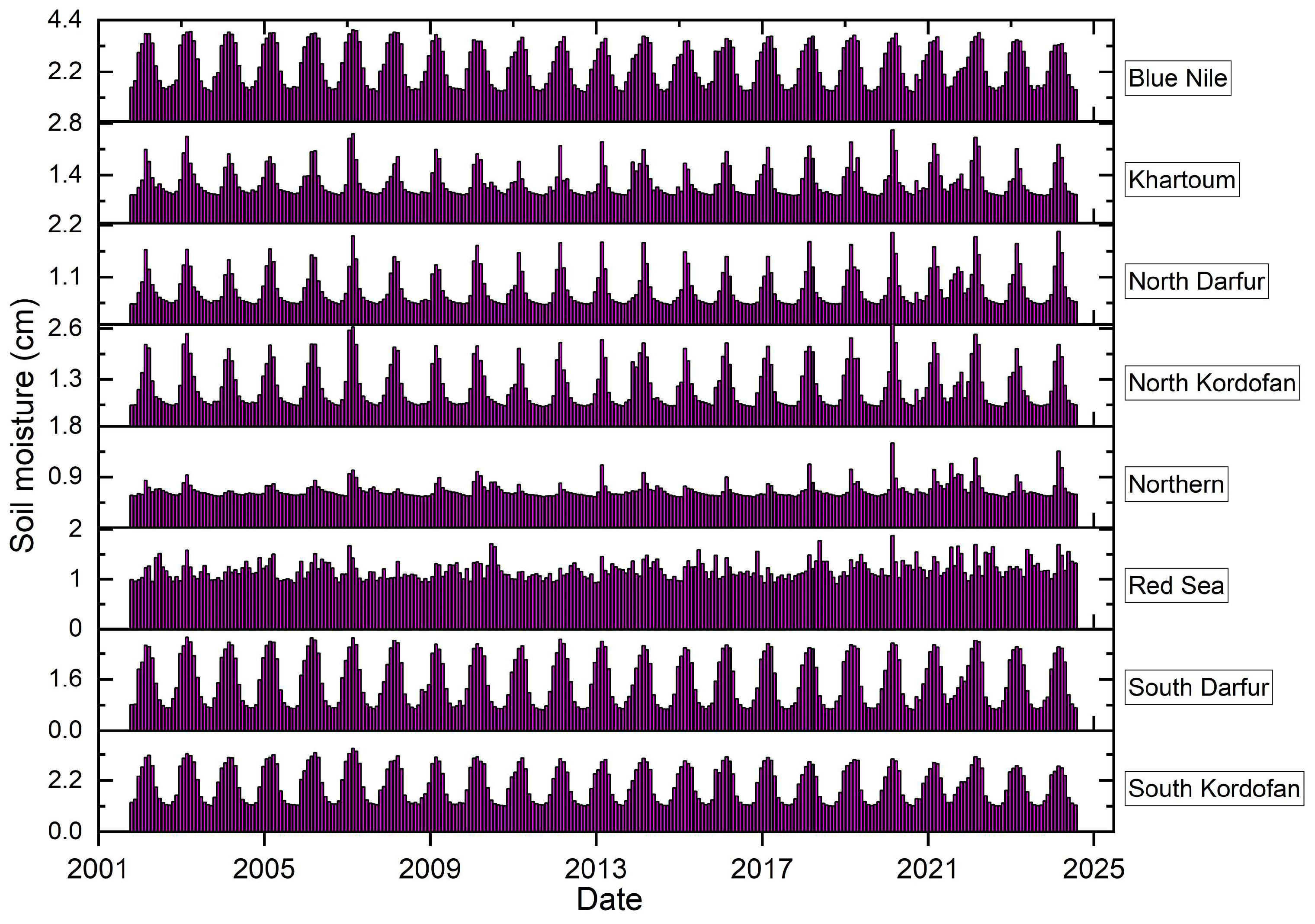
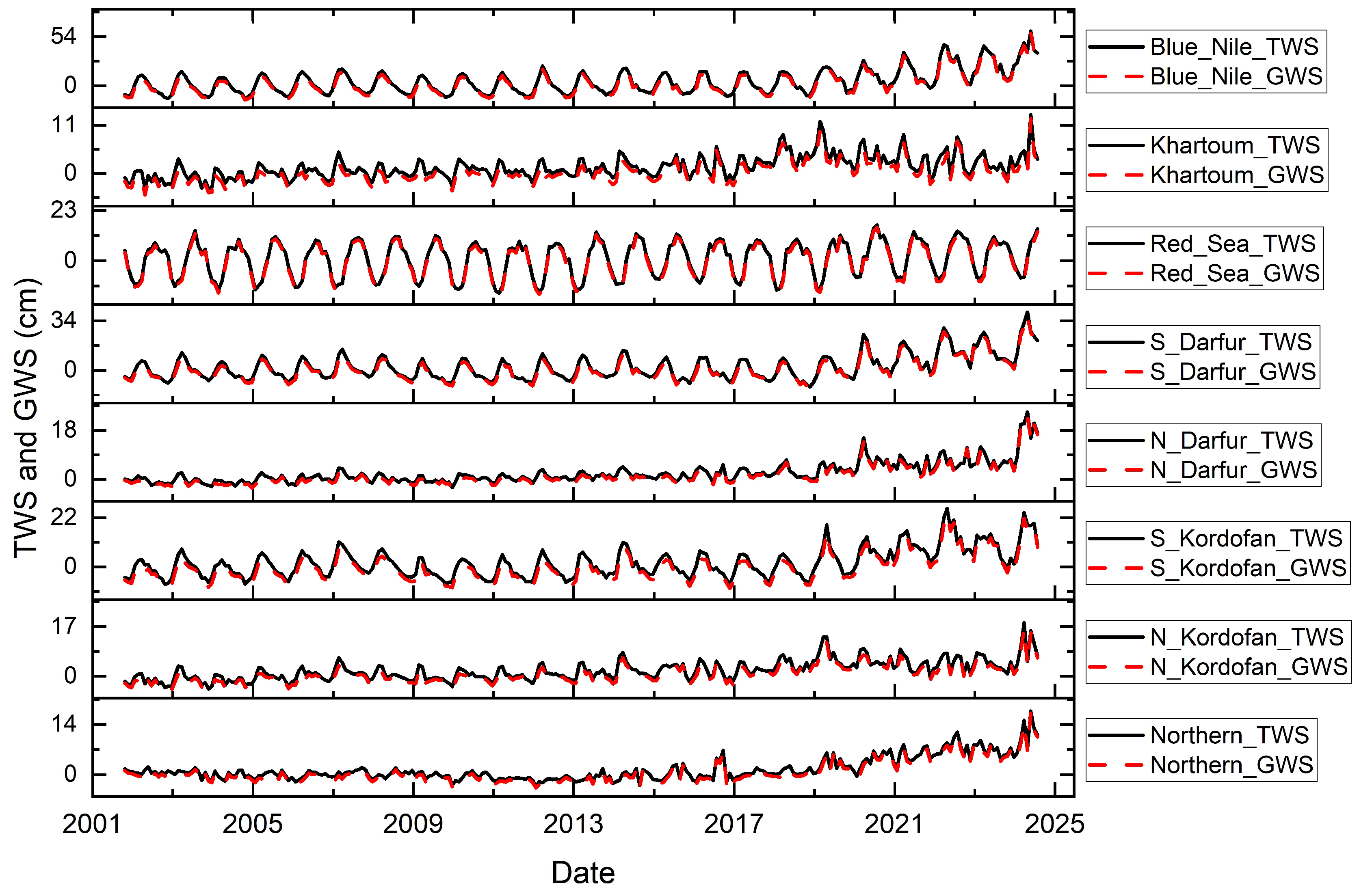

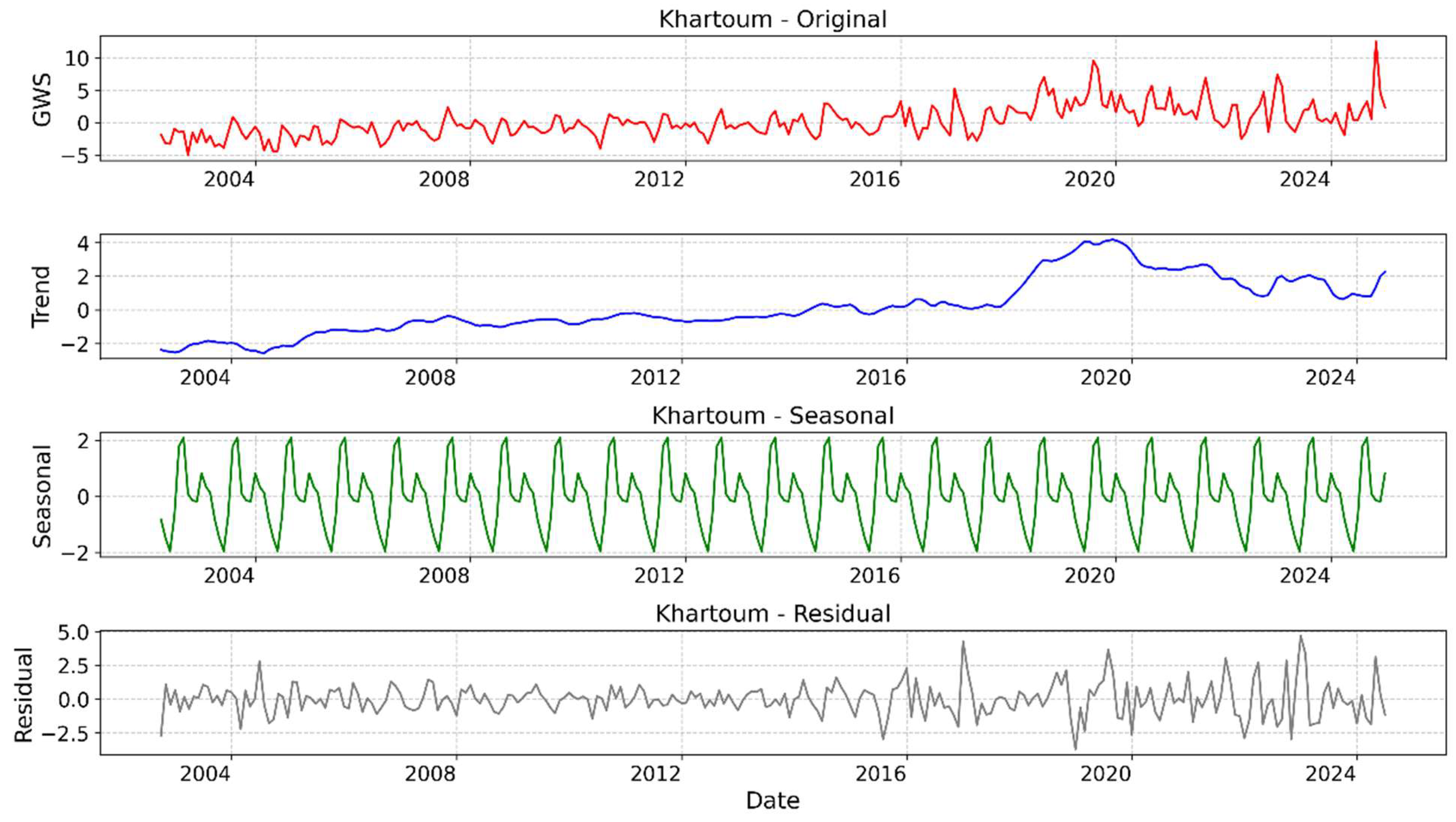
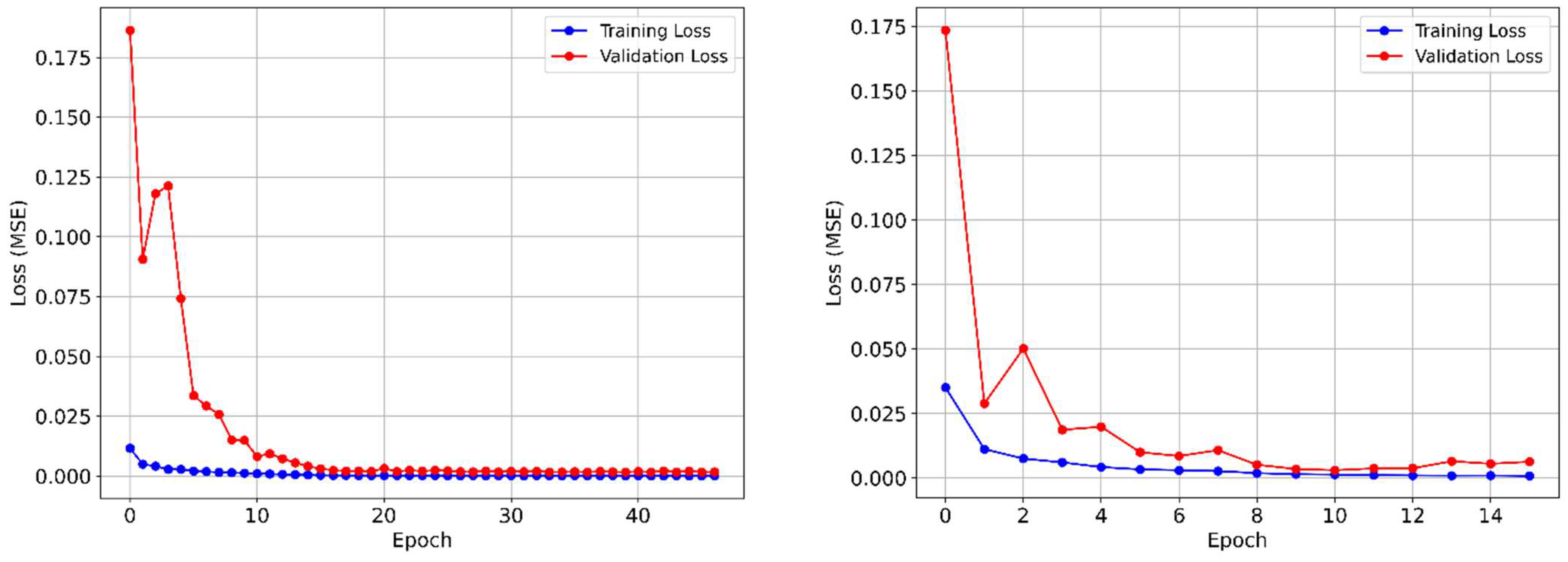
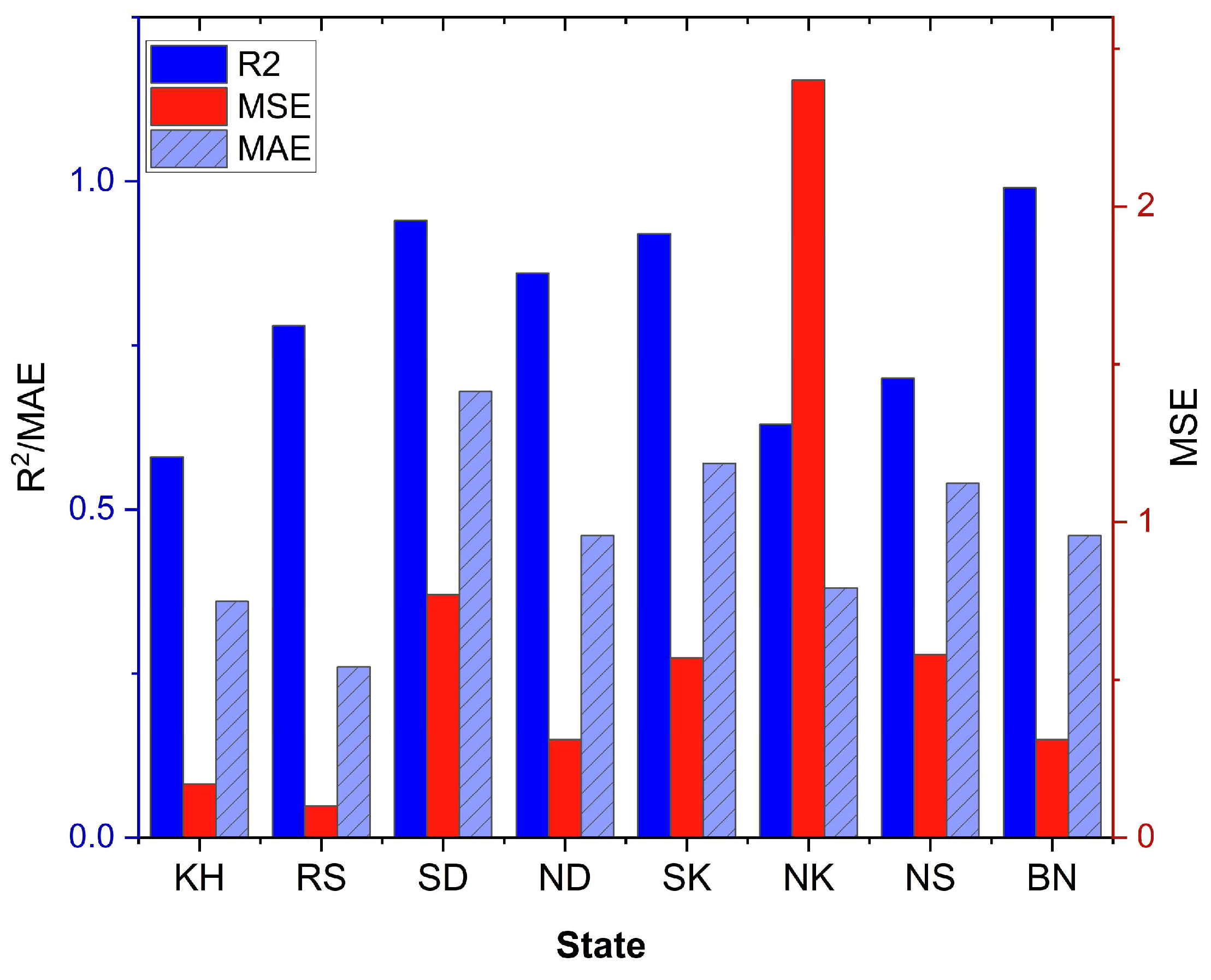
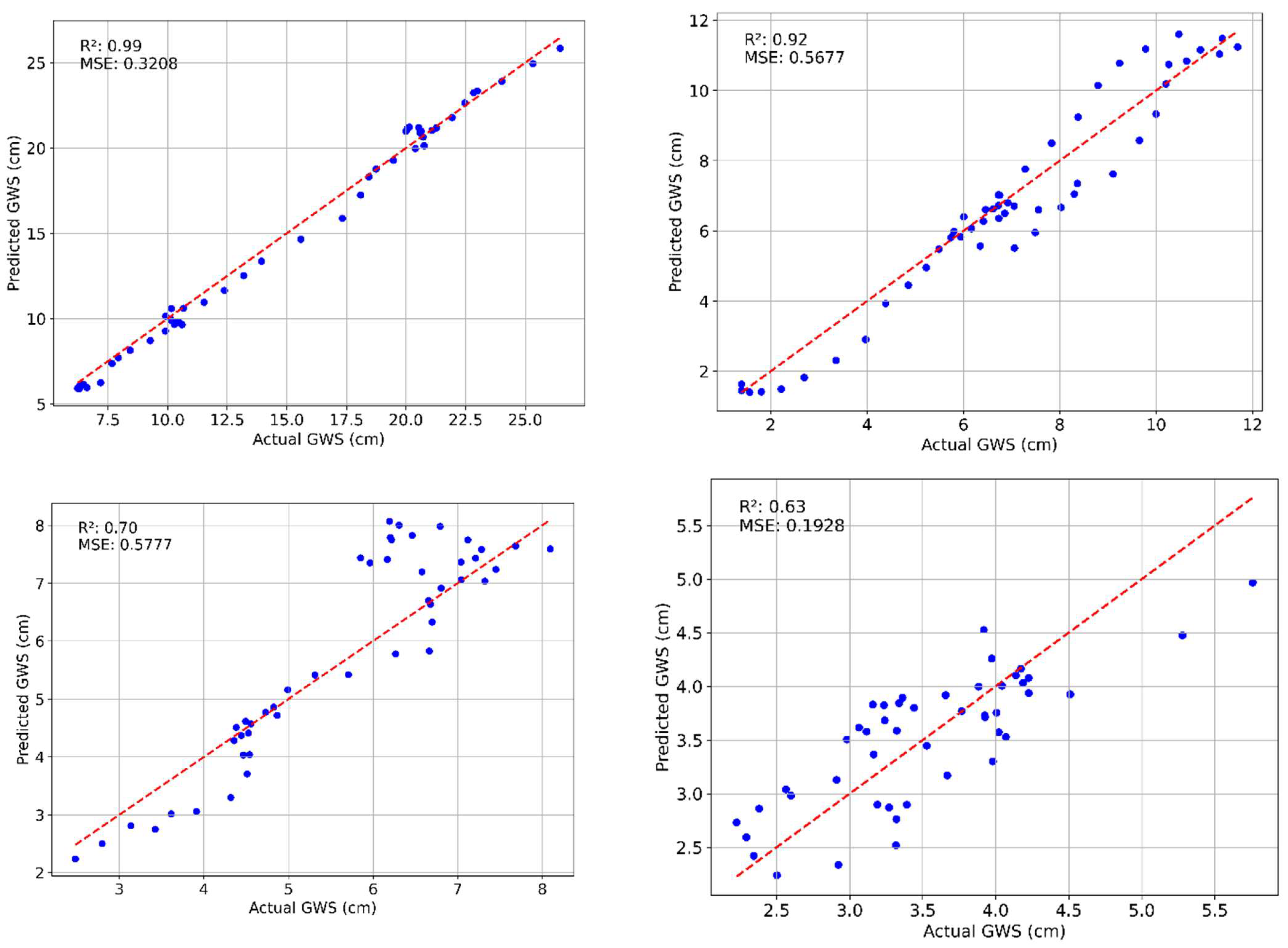
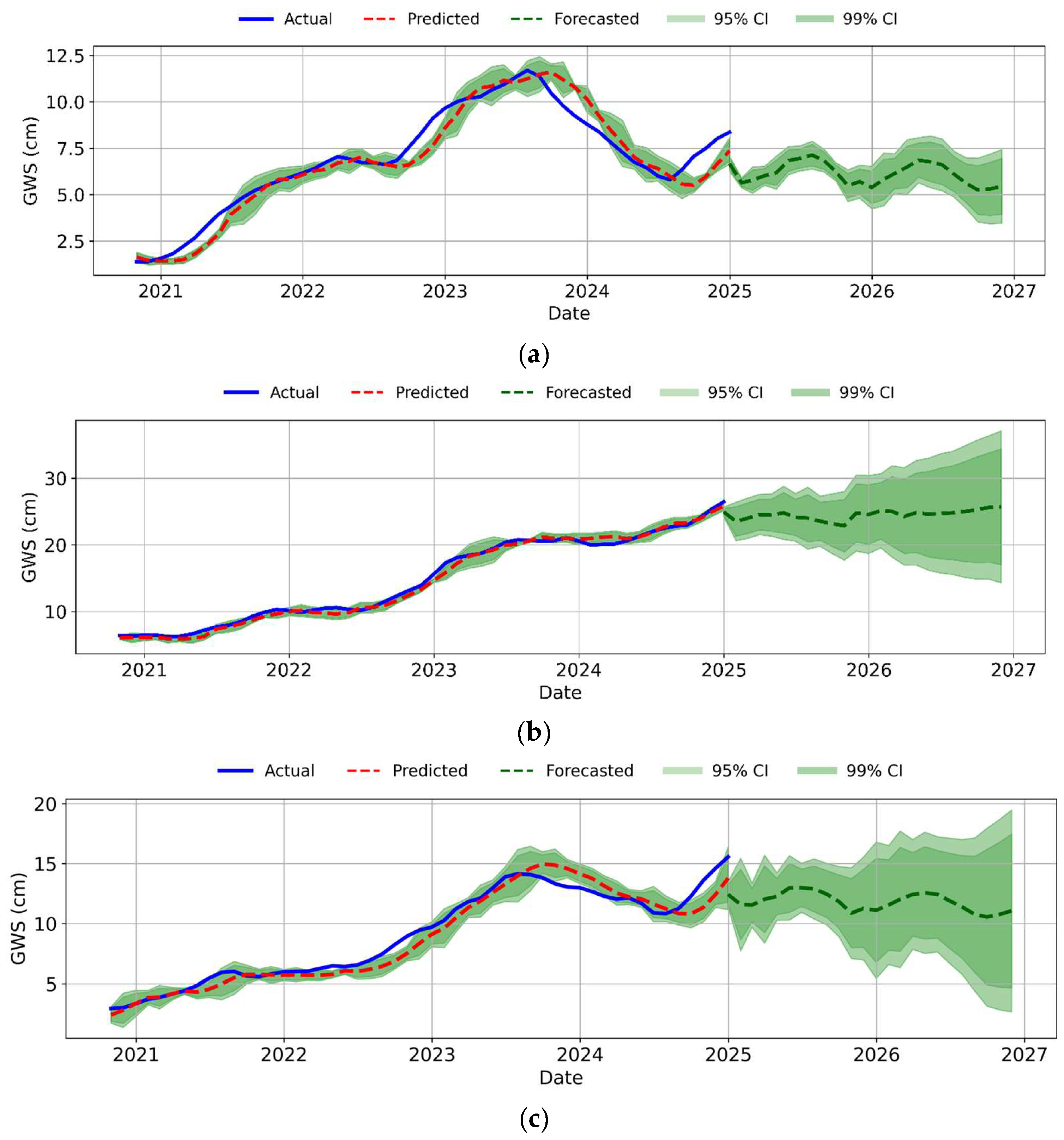
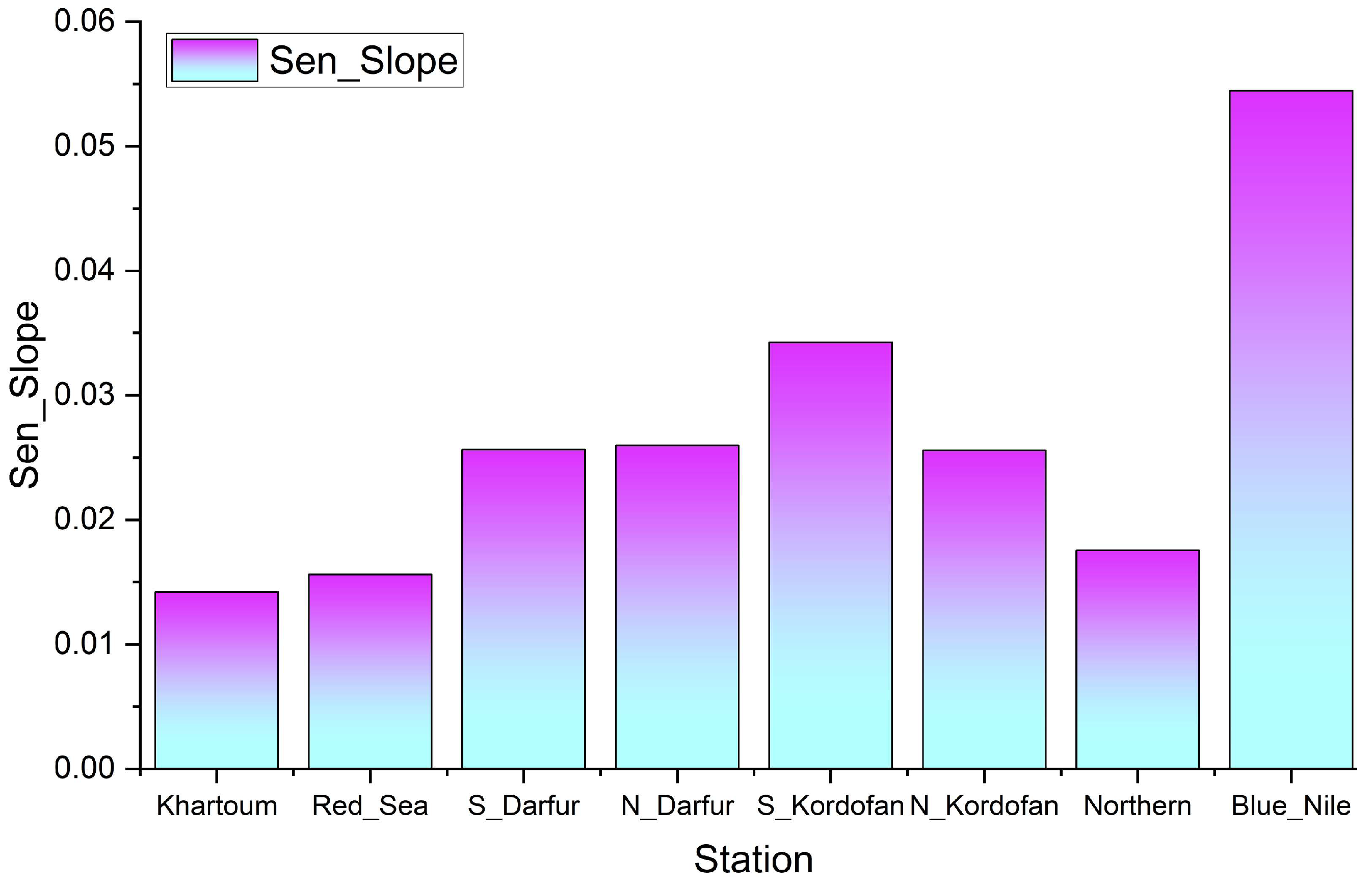
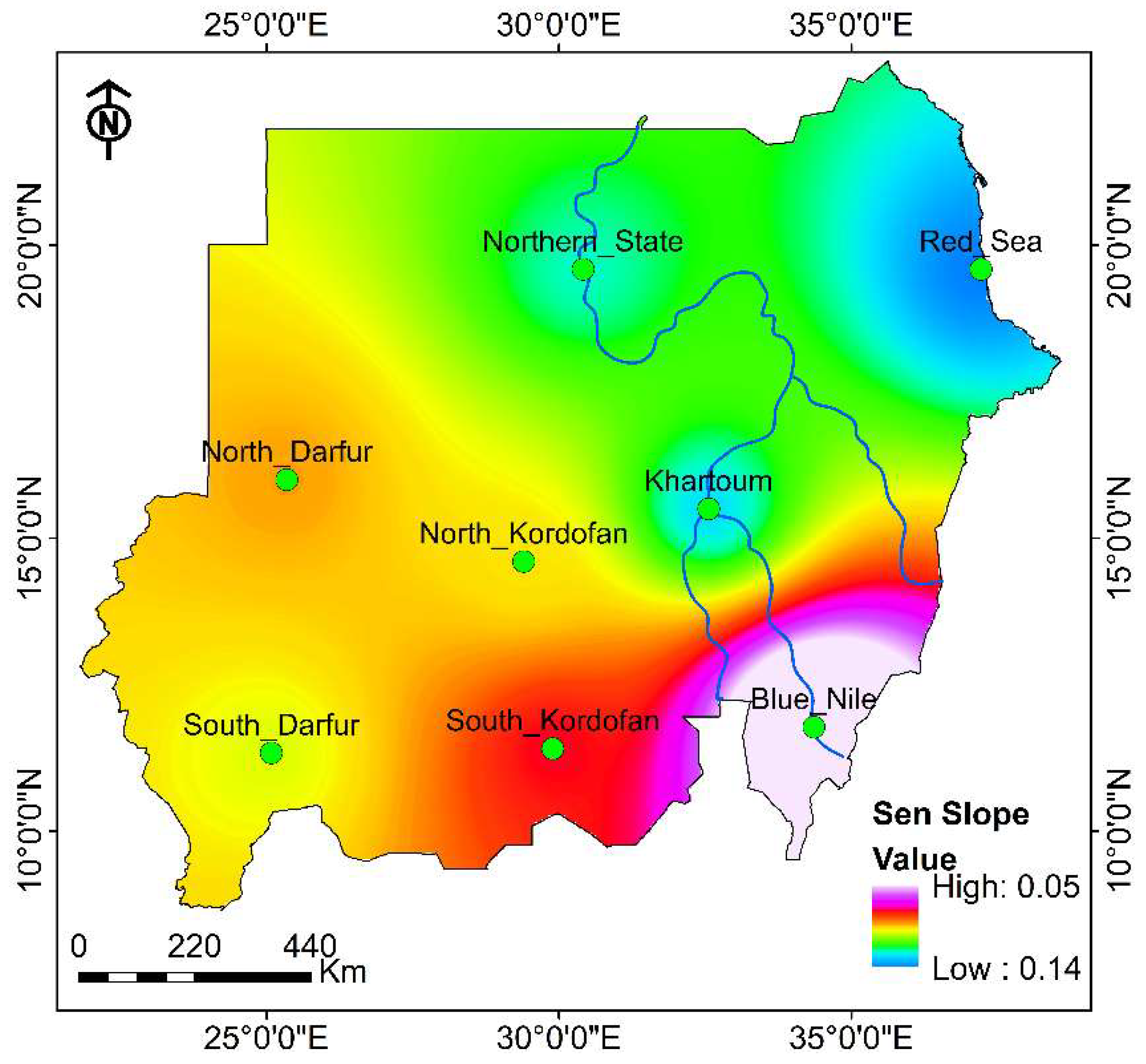
| Station | TWS Slope | GWS Slope | GWS_P-Value |
|---|---|---|---|
| Blue Nile | 0.0680 | 0.06836 | 1.4 × 10−14 |
| Khartoum | 0.01725295 | 0.01719349 | 8.85 × 10−25 |
| Red Sea | 0.01622208 | 0.01559514 | 0.002 |
| S_Darfur | 0.03498088 | 0.03584779 | 6.4 × 10−10 |
| N_Darfur | 0.0261725 | 0.02591174 | 7.70 × 10−45 |
| S_Kordofan | 0.03460569 | 0.03492199 | 5.7 × 10−15 |
| N_Kordofan | 0.02596833 | 0.0259267 | 2.00 × 10−33 |
| Northern | 0.0191607 | 0.01902034 | 9.60 × 10−17 |
Disclaimer/Publisher’s Note: The statements, opinions and data contained in all publications are solely those of the individual author(s) and contributor(s) and not of MDPI and/or the editor(s). MDPI and/or the editor(s) disclaim responsibility for any injury to people or property resulting from any ideas, methods, instructions or products referred to in the content. |
© 2025 by the authors. Licensee MDPI, Basel, Switzerland. This article is an open access article distributed under the terms and conditions of the Creative Commons Attribution (CC BY) license (https://creativecommons.org/licenses/by/4.0/).
Share and Cite
Mohammed, M.A.A.; Szabó, N.P.; Alao, J.O.; Szűcs, P. Deep-Learning-Based Probabilistic Forecasting of Groundwater Storage Dynamics in Sudan Using Multisource Remote Sensing and Geophysical Data. Remote Sens. 2025, 17, 3172. https://doi.org/10.3390/rs17183172
Mohammed MAA, Szabó NP, Alao JO, Szűcs P. Deep-Learning-Based Probabilistic Forecasting of Groundwater Storage Dynamics in Sudan Using Multisource Remote Sensing and Geophysical Data. Remote Sensing. 2025; 17(18):3172. https://doi.org/10.3390/rs17183172
Chicago/Turabian StyleMohammed, Musaab A. A., Norbert P. Szabó, Joseph O. Alao, and Péter Szűcs. 2025. "Deep-Learning-Based Probabilistic Forecasting of Groundwater Storage Dynamics in Sudan Using Multisource Remote Sensing and Geophysical Data" Remote Sensing 17, no. 18: 3172. https://doi.org/10.3390/rs17183172
APA StyleMohammed, M. A. A., Szabó, N. P., Alao, J. O., & Szűcs, P. (2025). Deep-Learning-Based Probabilistic Forecasting of Groundwater Storage Dynamics in Sudan Using Multisource Remote Sensing and Geophysical Data. Remote Sensing, 17(18), 3172. https://doi.org/10.3390/rs17183172






